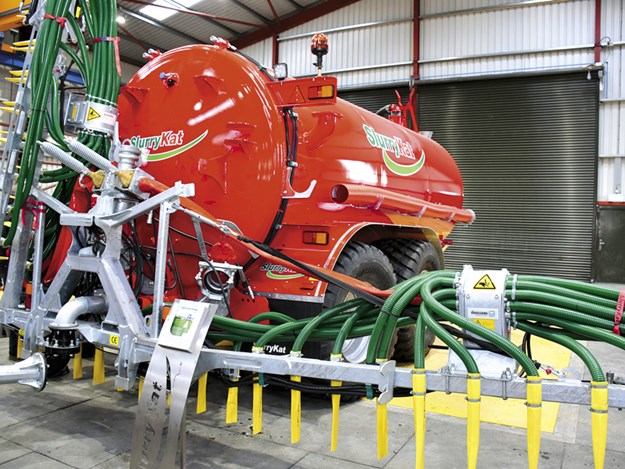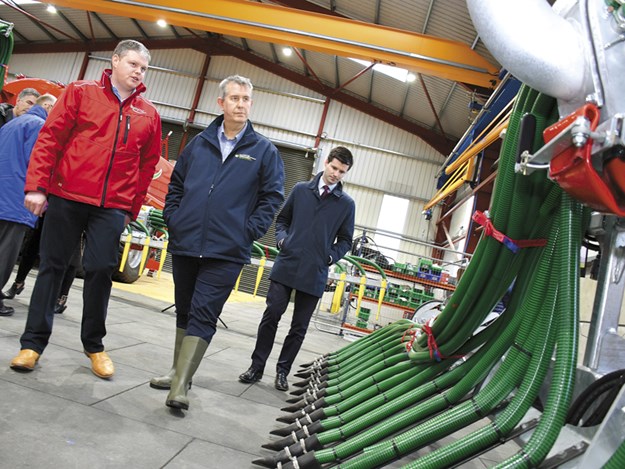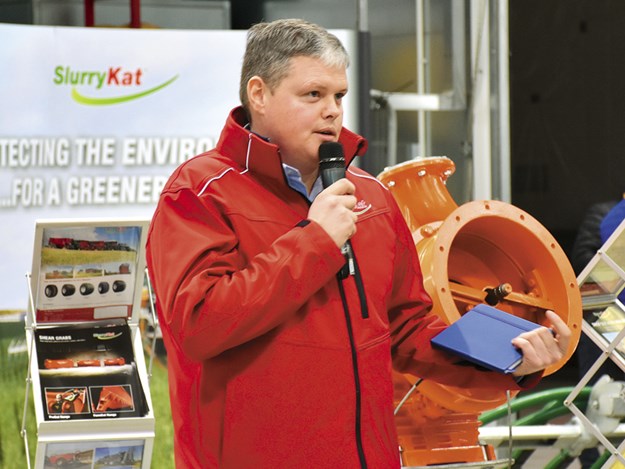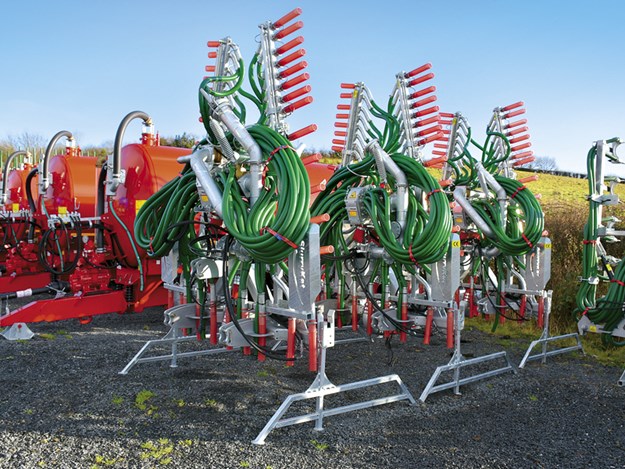Slurry spreading techniques under scrutiny
 Ready for action: A line-uo of SlurryKat spreading wagons
Ready for action: A line-uo of SlurryKat spreading wagons

 A range of Doda pumps at SlurryKat
A range of Doda pumps at SlurryKat

 Some of the other equipment on display
Some of the other equipment on display

 SlurryKat make a range of front reelers and trailing shoes
SlurryKat make a range of front reelers and trailing shoes

 The new Doda HD35 pump with extra metal in highwear areas
The new Doda HD35 pump with extra metal in highwear areas

 SlurryKat also make a range of mobile nurse tanks
SlurryKat also make a range of mobile nurse tanks




|
|
Ready for action: A line-uo of SlurryKat spreading wagons
|

|
|
A range of Doda pumps at SlurryKat
|

|
|
Some of the other equipment on display
|

|
|
SlurryKat make a range of front reelers and trailing shoes
|

|
|
The new Doda HD35 pump with extra metal in highwear areas
|

|
|
SlurryKat also make a range of mobile nurse tanks
|

|
Across the world in countries where a lot of slurry is produced from livestock farming, governments are clamping down on how the manure is spread. Chris McCullough takes a closer look at some of the information.
Pressure is mounting for a global reduction in emissions (such as ammonia) produced from agriculture, and many farmers will have to adopt new spreading methods to help governments reach their targets.
For years farmers and contractors in New Zealand and other countries have used tankers with the traditional splash plate on the rear to spread slurry, but that could be a distant memory if new regulations take hold.
Due to an increased concern about high ammonia emissions and harm to the environment when using these splash plates, new regulations may see a total ban on this piece of equipment in some countries by the year 2025.
As an example, for a few years now the UK government has called for a best-practice approach to slurry management, including spreading, to try and reduce emissions when spreading manure and ensure more nutrients reach the soil and not the atmosphere.
Around 88% of ammonia (NH3) emissions in the UK come from agriculture and it is a key air pollutant that can have significant effects on both human health and the environment. Nitrogen, in the form of ammonia, is lost from organic manures, such as slurry, solid manure and litter, digestate, sludge and compost, when they come into contact with air, particularly on warm or windy days.
Therefore, measures to reduce ammonia emissions and improve overall nutrient management practices could reduce the amount of manufactured fertiliser that farmers need, saving them money.
 |
|
The latest spreading technology on display at SlurryKat
|
The latest technology surrounding slurry spreading techniques show lower emissions when using the likes of trailing shoes, dribble bars and injection systems. Slurry spread with a splash plate can result in very high losses of 80-100% of the total ammonia.
These losses can be reduced by up to 60% if the slurry is spread by low emission spreading equipment such as the trailing shoe system. Splash plate systems also increase the risk of surface run-off into waterways.
With this in mind, together with the increased focus on the environment, Northern Ireland slurry equipment manufacturer SlurryKat recently held its first ever slurry spreading technology event at its County Armagh base.
Slurry equipment manufacturers are already producing low emission spreading equipment, but the end is near for the splash plate as 2025 has been earmarked for its demise. The SlurryKat event attracted around 800 farmers and contractors to the factory at Waringstown where spreading alternatives such as dribble bars, trailing shoes and umbilical systems were on display.
 |
|
SlurryKat CEO Garth Cairns, Daera Northern Ireland Agriculture Minister Edwin Poots, and DUP MLA Jonathan Buckley
|
SlurryKat CEO Garth Cairns says this was the first slurry spreading technology event of its kind and was happy with the turnout. "The focus of the indoor event was to highlight the imminent environmental regulations for spreading slurry on farms," he says. "It also showed farmers and contractors some of the low emission spreading methods that we have available to the industry to comply with the new regulations."
 |
|
SlurryKat CEO Garth Cairns outlines the company’s latest machinery
|
Regulations in Northern Ireland from the Nutrients Action Programme (NAP) states low emission application methods must be used for all anaerobic digestate spreading by February 2020; all slurry contractors by February 2021 and cattle farms with over 200 livestock units, or pig farms with total annual livestock manure nitrogen production of 20,000kg or more, by February 2022.
"During a number of meetings with government officials we have determined the splash plate will be banned across the board by 2025," Cairns says.
"This ban will be phased in starting this year for different sectors that use them."
He says SlurryKat has completely redesigned its entire range of spreading technology equipment over the last two years.
"Nowadays, the systems are much lighter, more efficient, have higher performance outputs and are wider ranging. They now perform best with all types of slurry and on steep slopes. "We have a system to suit every user right through from the small farmer to the larger contractor," he says.
The rest of the UK has also issued guidelines encouraging farmers and contractors to use the low emission spreading equipment in time before the ban kicks in. The problem, however, is the large number of smaller farmers who use tankers with splash plates and who could not justify the purchase of a new tanker with a dribble bar or even adding one to their existing tanker.
 |
|
SlurryKat’s 4,000 gallon Premium Plus tanker with 9m dribble bar
|
In Northern Ireland, the new Minister of Agriculture Edwin Poots, who attended the SlurryKat event, says: "There is an increasing and growing acceptance of the need to reduce ammonia, nitrates and phosphorus emissions into our air and water to prevent damage to sensitive sites, rivers and lakes, protect human health, help to meet UK targets and to improve the efficiency of nutrient use.
"In doing so, agricultural businesses have the added benefit of becoming more efficient by making better use of nutrients in slurries and reducing the need to buy chemical fertilisers," he says.
"There is no doubt of the complexities and challenges that face us when we try to protect our green lands whilst at the same time, support and encourage the rural sector to flourish.
 |
|
New dribble bars and tankers ready for dispatch
|
"While the use of low emission slurry spreading equipment such as trailing shoes and dribble bars is already significant, I would like to see much greater uptake of this highly beneficial technology on farms across Northern Ireland as it is a key contributor in making a sustainable future for Northern Ireland farming."
Find more slurry spreaders for sale in NZ
Keep up to date in the industry by signing up to Farm Trader's free newsletter or liking us on Facebook





.jpg)
.jpg)










